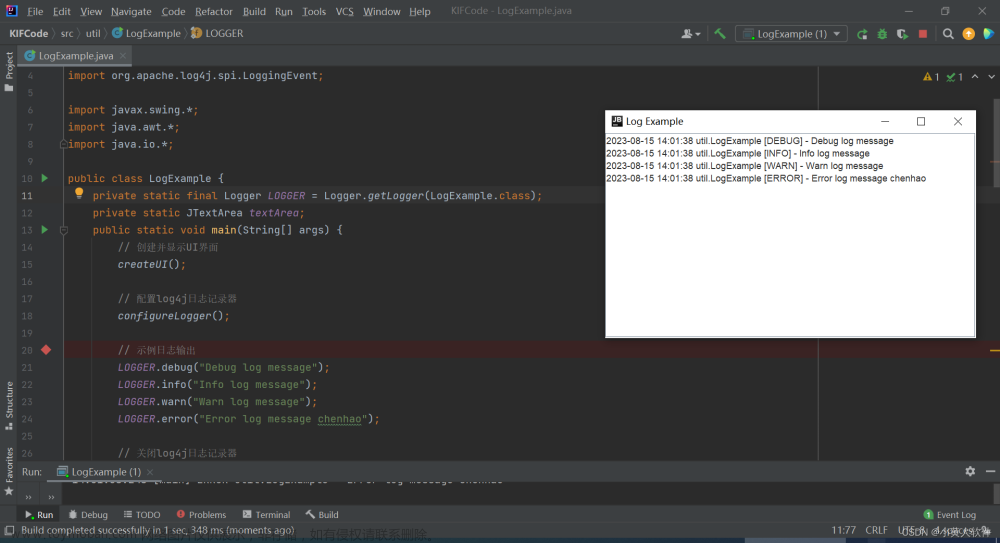前言
自己是如何使用单元测试
进行单元测试能够让我们在编写方法的具体实现代码后,能清晰地看到其是否能实现预期的功能,有助于我们及时修正自己方法中存在的bug,以免在后续使用到某方法时出现意想不到的错误。
一、引入单元测试所使用的依赖
<dependency>
<groupId>org.springframework.boot</groupId>
<artifactId>spring-boot-starter-test</artifactId>
<scope>test</scope>
<exclusions>
<!---如果不需要junit4就排除该依赖->
<exclusion>
<groupId>org.junit.vintage</groupId>
<artifactId>junit-vintage-engine</artifactId>
</exclusion>
</exclusions>
</dependency>
<dependency>
<groupId>org.jeasy</groupId>
<artifactId>easy-random-core</artifactId>
<version>4.3.0</version>
<scope>test</scope>
<exclusions>
<!-- 跟 SpringAOP 引入的 objenesis 有冲突,要排除 -->
<exclusion>
<groupId>org.objenesis</groupId>
<artifactId>objenesis</artifactId>
</exclusion>
</exclusions>
</dependency>
<!-- 支持根据参数校验逻辑生成对象字段 -->
<dependency>
<groupId>org.jeasy</groupId>
<artifactId>easy-random-bean-validation</artifactId>
<version>4.3.0</version>
<scope>test</scope>
<exclusions>
<exclusion>
<artifactId>snakeyaml</artifactId>
<groupId>org.yaml</groupId>
</exclusion>
</exclusions>
</dependency>
二、如何在Controller层进行单元测试?
代码如下(示例):
import org.junit.jupiter.api.BeforeEach;
import org.junit.jupiter.api.Test;
import org.springframework.boot.test.autoconfigure.web.servlet.AutoConfigureMockMvc;
import org.springframework.boot.test.context.SpringBootTest;
@SpringBootTest
@AutoConfigureMockMvc
class xxxTest{
@Autowired
private MockMvc mockMvc;
Headers headers = new Headers();
@BeforeEach
void setUp(){
// TODO 如果需要Token等内容可以在测试之前准备好
}
@Test
void testXxx(){
// 准备好Controller层所使用的参数
// 通过使用EasyRandom类生成随机参数
XxxVO vo = new EasyRandom().nextObject(XxxVO.class)
// 将参数转换为Json字符串
String content = JSONObject.toJSONString(vo);
// 发送请求
String contentAsString = mockMvc.perform(
// 发送Post请求
MockMvcRequestBuilders.post(url)
// 在header中添加参数,并设置编码
.headers(headers).contentType(MediaType.APPLICATION_JSON_VALUE)
// 发送的Json内容
.content(content.getBytes(StandardCharsets.UTF_8)).andReturn()
.getResponse().getContentAsString(StandardCharsets.UTF_8);
System.out.println(contentAsString);
}
}
三、如何在Service层进行单元测试?
代码如下(示例):
import org.junit.jupiter.api.Test;
import org.springframework.beans.factory.annotation.Autowired;
import org.springframework.boot.test.context.SpringBootTest;
import org.springframework.test.context.ActiveProfiles;
@SpringBootTest
@ActiveProfiles("dev")
class XxxTest(){
@Autowried
private XxxService xxxService;
@Test
@DisplayName("测试某个功能")
// 关闭该测试
@Disabled
void testXxx(){
}
}
总结
用JUnit编写测试类,进行单元测试能够让我们在编写方法的具体实现代码后,能清晰地看到其是否能实现预期的功能,有助于我们及时修正自己方法中存在的bug,以免在后续使用到某方法时出现意想不到的错误。
最后: 下方这份完整的软件测试视频教程已经整理上传完成,需要的朋友们可以自行领取【保证100%免费】
软件测试面试文档
我们学习必然是为了找到高薪的工作,下面这些面试题是来自阿里、腾讯、字节等一线互联网大厂最新的面试资料,并且有字节大佬给出了权威的解答,刷完这一套面试资料相信大家都能找到满意的工作。

 文章来源:https://www.toymoban.com/news/detail-809541.html
文章来源:https://www.toymoban.com/news/detail-809541.html
行动吧,在路上总比一直观望的要好,未来的你肯定会感谢现在拼搏的自己!如果想学习提升找不到资料,没人答疑解惑时,请及时点击加入群:1150305204 ,里面有各种测试开发资料和技术可以一起交流哦。文章来源地址https://www.toymoban.com/news/detail-809541.html
到了这里,关于自己是如何使用单元测试的文章就介绍完了。如果您还想了解更多内容,请在右上角搜索TOY模板网以前的文章或继续浏览下面的相关文章,希望大家以后多多支持TOY模板网!











